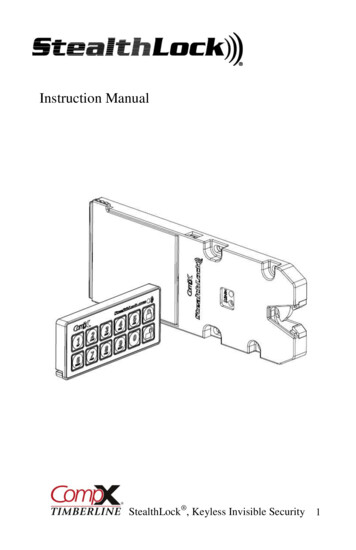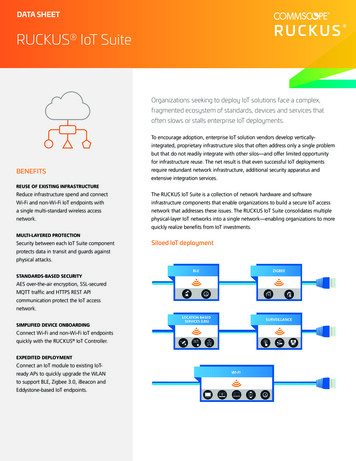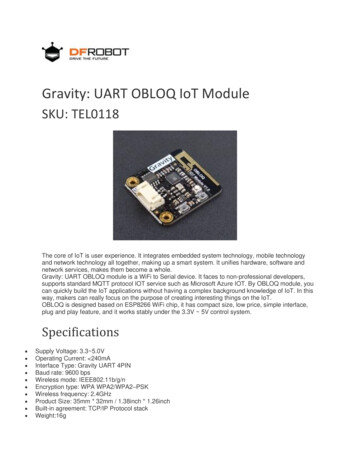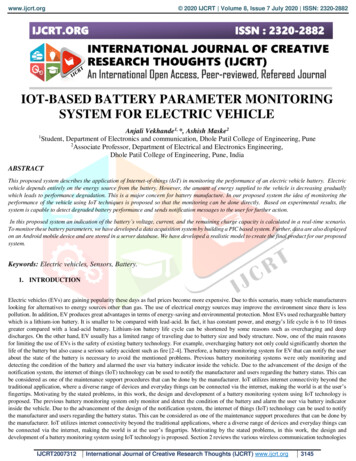
Transcription
www.ijcrt.org 2020 IJCRT Volume 8, Issue 7 July 2020 ISSN: 2320-2882IOT-BASED BATTERY PARAMETER MONITORINGSYSTEM FOR ELECTRIC VEHICLE1Anjali Vekhande1, *, Ashish Maske2Student, Department of Electronics and communication, Dhole Patil College of Engineering, Pune2Associate Professor, Department of Electrical and Electronics Engineering,Dhole Patil College of Engineering, Pune, IndiaABSTRACTThis proposed system describes the application of Internet-of-things (IoT) in monitoring the performance of an electric vehicle battery. Electricvehicle depends entirely on the energy source from the battery. However, the amount of energy supplied to the vehicle is decreasing graduallywhich leads to performance degradation. This is a major concern for battery manufacture. In our proposed system the idea of monitoring theperformance of the vehicle using IoT techniques is proposed so that the monitoring can be done directly. Based on experimental results, thesystem is capable to detect degraded battery performance and sends notification messages to the user for further action.In this proposed system an indication of the battery’s voltage, current, and the remaining charge capacity is calculated in a real-time scenario.To monitor these battery parameters, we have developed a data acquisition system by building a PIC based system. Further, data are also displayedon an Android mobile device and are stored in a server database. We have developed a realistic model to create the final product for our proposedsystem.Keywords: Electric vehicles, Sensors, Battery.1. INTRODUCTIONElectric vehicles (EVs) are gaining popularity these days as fuel prices become more expensive. Due to this scenario, many vehicle manufacturerslooking for alternatives to energy sources other than gas. The use of electrical energy sources may improve the environment since there is lesspollution. In addition, EV produces great advantages in terms of energy-saving and environmental protection. Most EVs used rechargeable batterywhich is a lithium-ion battery. It is smaller to be compared with lead-acid. In fact, it has constant power, and energy’s life cycle is 6 to 10 timesgreater compared with a lead-acid battery. Lithium-ion battery life cycle can be shortened by some reasons such as overcharging and deepdischarges. On the other hand, EV usually has a limited range of traveling due to battery size and body structure. Now, one of the main reasonsfor limiting the use of EVs is the safety of existing battery technology. For example, overcharging battery not only could significantly shorten thelife of the battery but also cause a serious safety accident such as fire [2-4]. Therefore, a battery monitoring system for EV that can notify the userabout the state of the battery is necessary to avoid the mentioned problems. Previous battery monitoring systems were only monitoring anddetecting the condition of the battery and alarmed the user via battery indicator inside the vehicle. Due to the advancement of the design of thenotification system, the internet of things (IoT) technology can be used to notify the manufacturer and users regarding the battery status. This canbe considered as one of the maintenance support procedures that can be done by the manufacturer. IoT utilizes internet connectivity beyond thetraditional application, where a diverse range of devices and everyday things can be connected via the internet, making the world is at the user’sfingertips. Motivating by the stated problems, in this work, the design and development of a battery monitoring system using IoT technology isproposed. The previous battery monitoring system only monitor and detect the condition of the battery and alarm the user via battery indicatorinside the vehicle. Due to the advancement of the design of the notification system, the internet of things (IoT) technology can be used to notifythe manufacturer and users regarding the battery status. This can be considered as one of the maintenance support procedures that can be done bythe manufacturer. IoT utilizes internet connectivity beyond the traditional applications, where a diverse range of devices and everyday things canbe connected via the internet, making the world is at the user’s fingertips. Motivating by the stated problems, in this work, the design anddevelopment of a battery monitoring system using IoT technology is proposed. Section 2 reviews the various wireless communication technologiesIJCRT2007312International Journal of Creative Research Thoughts (IJCRT) www.ijcrt.org3145
www.ijcrt.org 2020 IJCRT Volume 8, Issue 7 July 2020 ISSN: 2320-2882and wireless battery monitoring systems for industries and EVs, section 3 presents design and implementation of the system, section 4 describesdifferent tests performed, section 5 discusses the major issues faced and section 6 finally gives the conclusions of the work.2. PROPOSED METHODOLOGYThe block diagram of the proposed methodology is explained here in Figure. 1 The proposed system consists of different sensors like the currentsensor, voltage sensor, a temperature sensor for monitoring different battery conditions in the vehicle. Current sensor ACS712 is used to monitorthe current through battery and voltage sensor is used to monitor battery voltage in real-time. The voltage sensor can monitor the voltage of up to25V DC and the current sensor can monitor the current of up to 5A. The temperature sensor will monitor the temperature of the battery so that itwill decide the performance of the battery. The outputs of the current sensor, voltage sensor, and temp sensor are analog in nature and we need toconvert that analog output from the sensor into digital format, and for that, we are going to use inbuilt ADC of the controller which is 10-bit and13-channel ADC. The microcontroller used here is PIC18F4550 which is manufactured by Microchip Company. This information from sensors isprocessed in the controller and displayed on LCD. Also, this information is transferred to NodeMCU for uploading that information on the cloud.NodeMCU is having inbuilt Wi-Fi.Also, this information is accessed in an android app. A read API key is used to read data from the cloud and write API key is used towrite data on the cloud for monitoring purposes.3. Related work3.1 System FlowchartFigure 2 illustrates the source code flow of the system. Once the system is switched ON, it will start to initialize. Then, the voltage sensor measuresthe battery voltage and conveys it to a PIC microcontroller. Next, based on the received voltage data, the source code will verify the batterycondition. If the battery voltage exceeds the threshold, it will continue to read the battery voltage level. If the battery voltage level is low, anotification is shown to the system administrator using the web-based user interface. The user can check the critical battery condition. Same forTemperature and current sensor.Figure. 1 Block diagram of IoT based vehicle parameter monitoring3.2 Voltage MonitoringThe mileage and performance of an Electric Vehicle depends on the capacity and proficiency of its Battery Pack. To maintain the battery pack infull health is the responsibility of the Battery Management System (BMS). A BMS is a classy unit in an EV which does a lot of activity likechecking the cells, balancing them and even shielding them from temperature changes. We have already learnt enough of it in this BatteryManagement System article. To do anything, the first step for the BMS would be to know the current status of the cells in theLithium battery pack. This is done by measuring the voltage and current (sometimes temperature also) of the cells in the pack. Only with thesetwo values the BMS could calculate the SOC or SOH and perform cell balancing etc. So calculating the voltage and current of cell is vital for anyBMS circuit, be it a simple power bank or laptop battery or as difficult pack as EV/Solar batteries. In this article we will learn how we can measurethe specific cell voltage of the cells used in a Lithium battery pack.IJCRT2007312International Journal of Creative Research Thoughts (IJCRT) www.ijcrt.org3146
www.ijcrt.org 2020 IJCRT Volume 8, Issue 7 July 2020 ISSN: 2320-28823.3 Voltage Sensor ExperimentIn this experiment, the values of five (5) batteries were measured using a multimeter as shown in Figure 5. Then, these values were compared withthe values of the same batteries that were connected to the voltage sensor circuit as shown in Figure 6. The purpose is to show the differences andaccuracy percentage between both values. The selected batteries were varied in voltage values. The batteries were a mix of new and used ones.The results of the measurement will show these differences.Fig. 2 Flow ChartIJCRT2007312International Journal of Creative Research Thoughts (IJCRT) www.ijcrt.org3147
www.ijcrt.org 2020 IJCRT Volume 8, Issue 7 July 2020 ISSN: 2320-2882Fig. 3: Battery voltage measurement using multimeterVoltage sensorFig. 4: Battery voltage measurement using voltage sensor circuitTable 1: Voltage measurements resultsVoltage measurement resultsBattery 41.251.2353.813.79Accuracy percentage(%)99.4799.2998.2798.4099.48Table 1 shows the result of the experiments. As shown in the table, since the batteries were a mix of used and new batteries, the values are differentfrom each other. From the results, it shows that the accuracy of the voltage measurements taken from the voltage sensor is quite similar to themeasurements taken using a multimeter. Therefore, it can be concluded that the voltage sensor provides valid measurement values of the batteries.3.4 Current MonitoringThe electric vehicle market is pick up quite rapidly across the globe. Estimates show that the number of electric vehicles on the road around theworld will hit 125 million by 2030. The global market for Electric Vehicles (EV) and Hybrid. To control energy flow and increase efficiency inEV powertrain subsystems such as Traction Inverters, On-Board Chargers (OBC), DC-DC converters, and Battery Management Systems (BMS),exact and accurate current measurement is essential. These high-voltage subsystems essential to measure large currents at high common-modevoltages. For mechanical and controlling reasons, the current measurements need isolation as well as very high performance in harsh automotiveenvironments. One of the key features to make an electric vehicle safe is to collect data and take quick feedback actions locally based on this data.One such data point is very important and the key to safety is the current flowing across various sub-systems of an electric vehicle.IJCRT2007312International Journal of Creative Research Thoughts (IJCRT) www.ijcrt.org3148
www.ijcrt.org 2020 IJCRT Volume 8, Issue 7 July 2020 ISSN: 2320-28823.5 Battery Capacity:Electric carmakers have long been clamoring for a battery breakthrough that will improve the range of their vehicles while also extending theirlifespans. Most current electric cars are power-driven by “wet” lithium-ion batteries, which use liquid electrolytes to transfer energy around. Solidstate batteries have cells that are made of solid and “dry” conductive material, but that technology is still stuck in the lab and hasn’t made it toproduction. Liquid electrolytes in its lithium-ion batteries, but there’s one major difference: the company exchanges the organic (and highlyflammable) solvent containing the electrolytes with an inorganic substance that’s more stable and less flammable. We take the living materials outand replace them with nonliving or basically salt-like materials, and that does two things for you, Green shields says. “One is it gets rid of yourfire risk, so, of course, there’s nothing to burn. And another part is also got freed of the most reactive components in the system, which makes iteasier to build a battery where you can pack in a lot of energy lacking the thing becoming unsteady.” The organic materials found in most lithiumion batteries are the “principal source of side reactions,” which, over time, can consume the energetic constituents in the battery and turn the wholeclosed-loop system into something “non-productive,”.3.6 Battery Discharge CalculatorUsing a battery discharge calculator can give a deeper understanding of how different battery materials affect the discharge rate. Carbon-zinc,alkaline, and lead-acid batteries generally reduce efficiency when they discharge too fast. Calculating discharge rate lets quantify this. Thedischarge of a battery provides you with methods of calculating other values such as capacitance and the discharge rate constant. For a givencharge given off by a battery, the battery’s capacitance (not to be confused with capacity, as discussed earlier) C is given by C Q/V for a givenvoltage V. The capacitance, measured in farads, measures the battery’s ability to store charge. A capacitor arranged in series with a resistor canlet you calculate the product of capacitance and resistance of the circuit that gives you the time constant as RC. The time constant of this circuitarrangement tells you the time it takes for the capacitor to consume about 46.8percent of its charge when discharging through a circuit. The timeconstant is also the circuit’s response to a constant voltage input so engineers frequently use the time constant as a cutoff frequency for a circuit.3.7 Temperature MonitoringLow battery temperature will slow the charging rate while too high battery temperature will create a risk. Maintaining the correct chargingtemperature range has the added advantage of increasing battery life expectancy. Li-Ion batteries typically increase 5C (9F) in temperature duringthe 2-3 hours required for charging. This temperature upswing is normal and due to the chemical reaction taking place during the charging cycle.To avoid risk, the battery must not be allowed to increase more than 10C (18F) during charging. The ambient temperature in the instantaneousenvironment of the battery contributes deeply to the temperature of the battery during the charging cycle. The heat produced by the chemicalreaction of charging acts to rise in the initial temperature of the battery. The optimum Li-Ion battery temperature range during charging is quitenarrow, between 10C and 30C (41F to 86F). Fast charging, while acceptable, requires that battery temperature not exceed 45C (113F). Chargingabove 45C (113F) will degrade battery performance.3.8 Current sensorA current sensor is a device that senses electric current in a wire and produces a signal proportional to that current. The created signal could beanalog voltage or current or even a digital output. The generated signal can then be used to display the measured current in the measurement, orplaced in the data acquisition system for further analysis, or used for control. ACS712 Current Sensor Module - 30A can sense up to 30A of currentflow. ACS712 Current Sensor Module - 30A is based on the ACS712 sensor, which can accurately sense AC or DC current. The all-out AC orDC that can be detected can reach 30A, and the present current signal can recite via analog I/O port of a microcontroller.3.9 Battery Monitoring SystemUser Interface The developed battery monitoring system is also consists of a web-based user interface. The user interface is capable to monitormultiple battery monitoring devices’ locations, and the conditions of batteries. Therefore, the idea of the user interface has taken into considerationthe situation where there is a need to monitor multiple batteries conditions. Figure 11 shows the main page for the web-based user interface. Auser needs to login prior to use the interface. The login page is built for a secure data handling, where user is required to key-in username andpassword.IJCRT2007312International Journal of Creative Research Thoughts (IJCRT) www.ijcrt.org3149
www.ijcrt.org 2020 IJCRT Volume 8, Issue 7 July 2020 ISSN: 2320-28821. Log-in screenFig. 5: User interface for the proposed battery monitoring system2.Details ScreenFig. 6: User interface for the proposed battery monitoring systemIJCRT2007312International Journal of Creative Research Thoughts (IJCRT) www.ijcrt.org3150
www.ijcrt.org 2020 IJCRT Volume 8, Issue 7 July 2020 ISSN: 2320-28824. CONCLUSIONElectric Vehicles are having enormous potential for future transport communication, by exchanging the present conventional vehicles. EVs willbe becoming much eco-friendlier by saving the planet from global warming, by reducing the greenhouse gases emitted from present vehicles. Thesensor-based technologies for different configurations of EVs are discussed in detail in this chapter. Sensors for automotive applications, some ofthem which are also common in EVs, are discussed in detail. Finally, we have reported about the various kinds of micro-fabricated sensors thatare recently coming into play through MEMS-based researches and can be used for applications like motion sensing, battery sensing, energyharvesting, etc. This miniaturized sensor will help to reduce the cost, space, and give better sensing capability for the upcoming vehicles. Further,research needs to be done by the laboratories in collaboration with the automobile industries on EVs and its sensors to give all of us a better futurewith a pollution-free environment. A Lithium-ion batteries real-time monitoring system was proposed based on the on-board monitoring devicewith various Sensors connected to it, an android smartphone with Web-based Application displays Battery Parameter Values with and WithoutLoad. It can collect and display the voltage, current, temperature parameters of batteries by a phone. An actual Prototype was designed and hasproved the system being feasible. Future work of this will be done on the exact determination of the batteries states through data analyses on thecloud server, which will help repairers diagnose and maintenance remotely.5.REFERENCES[1] Basu AK, Sah AN, Pradhan A, Bhattacharya S (2018) BSA Detection on polymeric nanocantilever, pp 1–6[2] Basu AK, Sarkar H, Bhattacharya S (2016)[3] Fabrication and resilience measurement of thin aluminum cantilevers using scanning probe microscopy. In: Proceedings of the 3rd internationalconference C2E2 in foundations and frontiers in computer, communication and electrical engineering, Taylor and Francis, Mankundu, pp 457 460[4] Carley (2014) The beginners guide to electric vehicles (EV)[5] Chan CC (2002) The state of the art of electric and hybrid vehicles [Prolog]. Proc IEEE 90:245– 246.https://doi.org/10.1109/JPROC.2002.989872[6] Dixon (2007) Prospects for MEMS in the automotive industry[7] Ernest P (2010) MEMS@Bosch: Automotive Application and beyond[8] Gao Y, Ehsani M (2010) Design and control methodology of plug-in hybrid electric vehicles. IEEE Trans Indust Electron pp 633–640[9] Grunditz EA, Thiringer T (2016) Performance analysis of current BEVs based on a comprehensive review of specifications. IEEE Trans TranspElectrif 2:270–289. https://doi.org/10.1109/TTE. 2016.2571783[10] Irene Berry MK (2009) What’s the deal with hybrid and electric cars?[11] Klomp M, Gao Y, Bruzelius F (2014) Longitudinal velocity and road slope estimation in hybrid electric vehicles employing early detectionof excessive wheel slip. Veh Syst Dyn 52:172–188. https://doi.org/10.1080/00423114.2014.887737[12] S. Yonghua, Y. Yuexi, H. Zechun, “Present Status and Development Trend of Batteries for Electric Vehicles,” Power System Technology,Vol. 35, No. 4, pp. 1-7, 2011.[13] L. Xiaokang, Z. Qionghua, H. Kui, S. Yuehong, “Battery management system for electric vehicles,” J.Huazhong Univ. Of Sci. & Tech.(Nature Science Edition). Vol. 35, No. 8, pp. 83-86, 2007.[14] C. Piao, Q. Liu, Z. Huang, C. Cho, and X. Shu, “VRLA Battery Management System Based on LIN Bus for Electric Vehicle,” AdvancedTechnology in Teaching, AISC163, pp. 753-763, 2011.IJCRT2007312International Journal of Creative Research Thoughts (IJCRT) www.ijcrt.org3151
Figure. 1 Block diagram of IoT based vehicle parameter monitoring 3.2 Voltage Monitoring The mileage and performance of an Electric Vehicle depends on the capacity and proficiency of its Battery Pack. To maintain the battery pack in full health is the responsibility of the Battery Management System (BMS). A BMS is a classy unit in an EV which .

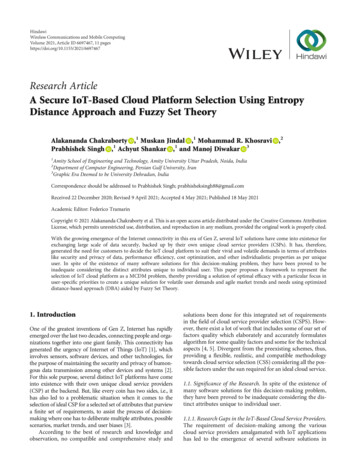

![Smarter Battery Crack [2022-Latest]](/img/13/eliamari.jpg)


